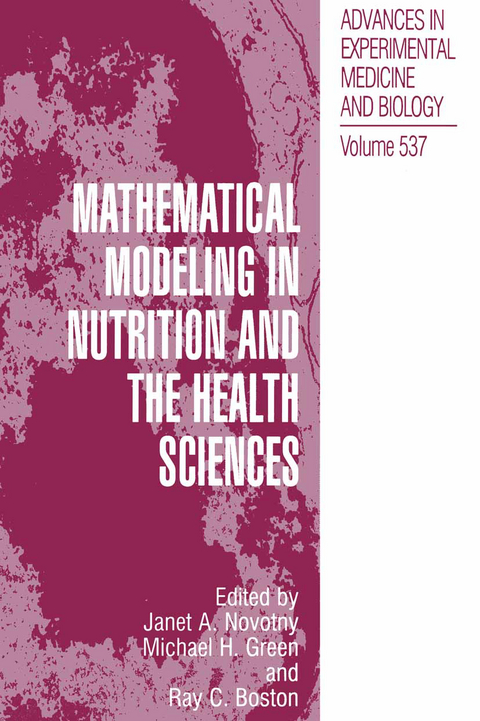
Mathematical Modeling in Nutrition and the Health Sciences
Springer-Verlag New York Inc.
978-1-4613-4759-0 (ISBN)
With advances in the abilityof modelstoaccesslargedatabases(e. g. ,apopulationofindividualpatientrecords)andthe developmentofuserinterfaces thatare"friendly"enough tobeused byclinicians who arenotmodelers, wepredictthathealthapplicationsmodeling willbeanimportantnew 51 directionformodelinginthe21 century. This book contains manuscripts that are based on presentations at the seventh conference in a series focused on advancing nutrition and health research by fostering exchange among scientists from such disciplines as nutrition, biology, mathematics, statistics,kinetics,andcomputing. Thethemesofthesixpreviousconferencesincluded general nutritionmodeling(CanoltyandCain, 1985;Hoover-PlowandChandra, 1988), amino acids and carbohydrates (Aburnrad, 1991), minerals (Siva Subramanian and Wastney, 1995),vitamins,proteins,andmodelingtheory(CoburnandTownsend, 1996), and physiological compartmental modeling (Clifford and Muller, 1998). The seventh conference in the series was held at The Pennsylvania State University from July 29 throughAugust1,2000.
Themeetingbeganwithaninstructiveandentertainingkeynote address by Professor Britton Chance, Eldridge Reeves Johnson University Professor Emeritus of Biophysics, Physical Chemistry, and Radiologic Physics, University of Pennsylvania. Dr.
Historical Perspectives and Future Directions.- The Minimal Model of Glucose Regulation: a Biography..- Cornerstones to Shape Modeling for the 21STCentury: Introducing the Aka-Glucose Project.- Development and Use of Mathematical Models.- Aspects of Effective Modeling.- Fitting a Mathematical Model to Biological Data: Intracellular Trafficking in Niemann-Pick C Disease.- A Saturation Kinetic Model to Teach Balance of Essential Fatty Acids in Nutrition Education.- Theoretical Modeling Issues.- Modeling Processes from Probabilities.- Understanding the Relationship Between Carcinogen-Induced Dna Adduct Levels in Distal and Proximal Regions of the Colon.- Experimental Aspects of Kinetic Data.- Methodological Issues in Stable Isotope- Based Kinetic Studies in Children.- Intrinsic Labeling of Plants for Bioavailability Studies.- Elemental Mass Spectrometry for Compartmental Biological Modeling.- Modeling of Vitamins, Minerals, and Cholesterol.- The Use of Model-Based Compartmental Analysis to Study Vitamin a Metabolism in a Non-Steady State.- Modeling Short (7 Hour)- and Long (6 Week)-Term Kinetics of Vitamin B-6 Metabolism with Stable Isotopes in Humans.- Calcium Utilization in Young Women: New Insights from Modeling.- Modeling Cholesterol in Humans: Update and Dealing with the Problem of Exchange in Vivo Using the Blood Cell-Lipoprotein Paradigm.- Modeling of Protein Metabolism, Energy, and Growth.- Challenging the Assumptions in Estimating Protein Fractional Synthesis Rate Using a Model of Rodent Protein Turnover.- Simulating Patterns of Change in Rates of Secretion of Protein into Milk.- Mechanistic Equations to Represent Digestion and Fermentation.- Modeling Growth of Cattle for Application within the Structure of the Cornell Net Carbohydrate and Protein System.- Modeling to Explore Disease.- Mathematical Models of Tumor Growth: from Empirical Description to Biological Mechanism.- A Systems Modeling Approach to the Study of Retinoid Function: Implications for Evaluation of Retinoids in Cancer Chemoprevention and/or Chemotherapy.- Glutamate Metabolism in Primary Cultures of Rat Brain Astrocytes: Rationale and Initial Efforts Toward Developing a Compartmental Model.- State-of-the-Art Modeling Software.- WinSAAM: Application and Explanation.- Stata: a Statistical Analysis System for Examining Biomedical Data.- Using Advanced Continuous Simulation Language (Acsl) to Simulate, Solve, and Fit Mathematical Models in Nutrition.- Solving and Fitting France’s Rumen Model with Mlab.- Stella® Research Software for Teaching Concepts of Nutrient Dynamics in the Undergraduate Classroom.- A Review of ‘Scientist’ Software.
| Reihe/Serie | Advances in Experimental Medicine and Biology ; 537 |
|---|---|
| Zusatzinfo | XXV, 420 p. |
| Verlagsort | New York, NY |
| Sprache | englisch |
| Maße | 155 x 235 mm |
| Themenwelt | Mathematik / Informatik ► Informatik ► Software Entwicklung |
| Mathematik / Informatik ► Mathematik ► Algebra | |
| Mathematik / Informatik ► Mathematik ► Angewandte Mathematik | |
| Naturwissenschaften ► Biologie ► Biochemie | |
| ISBN-10 | 1-4613-4759-9 / 1461347599 |
| ISBN-13 | 978-1-4613-4759-0 / 9781461347590 |
| Zustand | Neuware |
| Haben Sie eine Frage zum Produkt? |
aus dem Bereich


